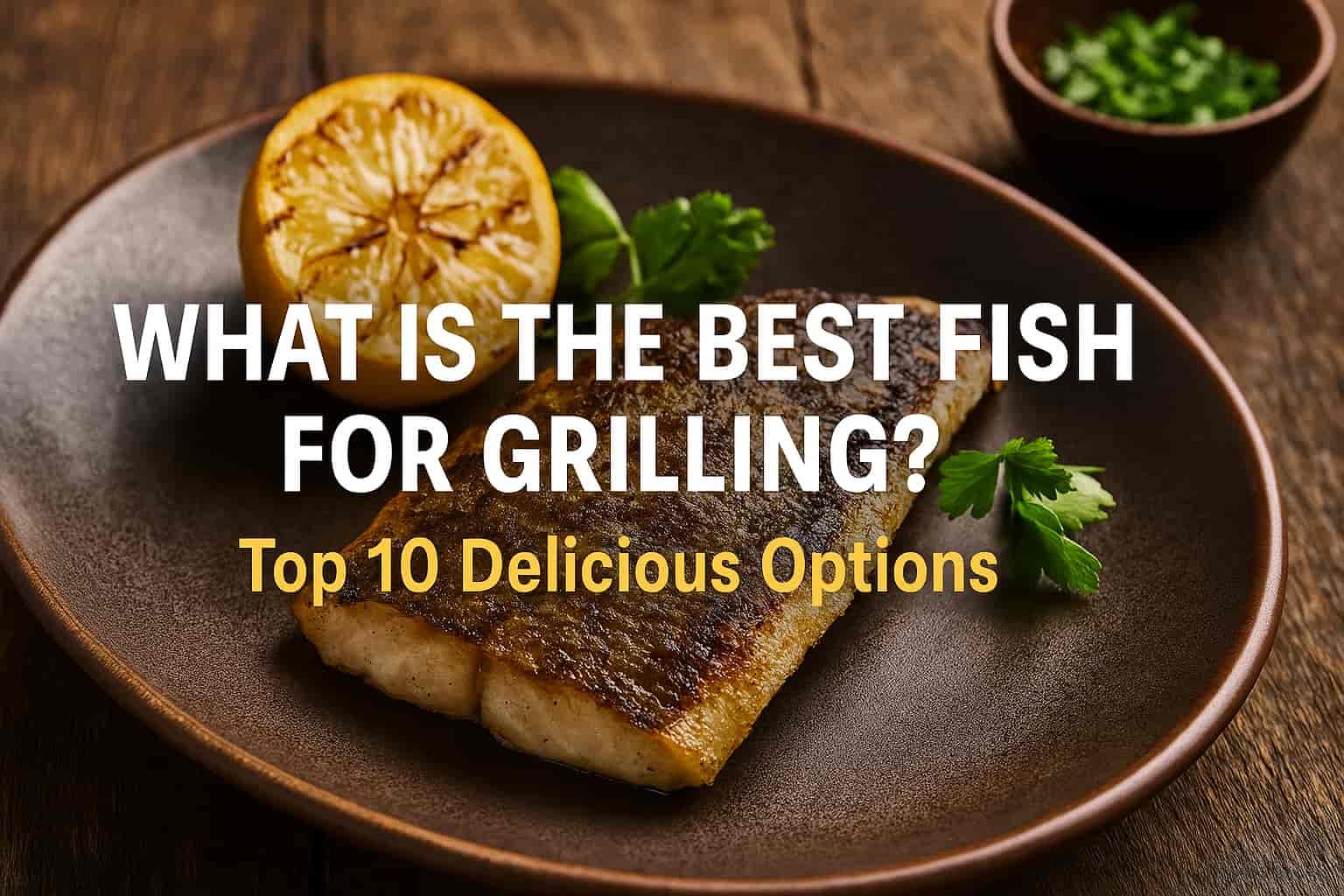Grilling fish delivers rich, smoky flavors that elevate simple ingredients into gourmet meals. However, choosing the right fish for grilling is critical to avoid broken fillets and disappointing textures. Not all fish possess the firmness, fat content, or structural integrity needed to withstand high heat and direct flames. Selecting the wrong type can result in dry, flaky, or crumbled pieces falling through the grates.
In this comprehensive guide, you’ll discover the key qualities that make a fish ideal for grilling, the top 10 species that deliver consistently delicious results, and expert preparation techniques to prevent sticking and preserve moisture. Whether you’re an experienced grill master or a beginner planning your first seafood barbecue, this resource provides actionable answers to ensure perfectly grilled fish every time.
Contents
- 1 What Qualities Make a Fish Ideal for Grilling?
- 2 Which Are the Top 10 Fish Species Recommended for Grilling?
- 2.1 Is Salmon a Good Choice for Grilling?
- 2.2 How Does Tuna Hold Up on the Grill?
- 2.3 Why Is Swordfish Considered a Grilling Favorite?
- 2.4 Can You Successfully Grill Mahi-Mahi?
- 2.5 What Makes Halibut Suitable for Grilling?
- 2.6 Is Sea Bass a Good Option for Grilled Dishes?
- 2.7 How Does Snapper Perform on the Grill?
- 2.8 Should You Try Grilling Catfish?
- 2.9 Is Trout a Reliable Fish for Grilling?
- 2.10 Can Sardines Be Grilled Successfully?
- 3 How Should You Prepare Fish for Grilling to Avoid Sticking and Falling Apart?
- 4 Which Grilling Methods Are Best for Different Types of Fish?
- 5 What Are the Health Benefits of Grilling Fish Compared to Other Cooking Methods?
- 6 Which Types of Fish for Grilling Are Considered Sustainable Choices?
- 7 How Do You Pair Grilled Fish with Side Dishes and Sauces for a Complete Meal?
What Qualities Make a Fish Ideal for Grilling?
A fish is ideal for grilling when it has firm flesh, moderate to high fat content, and intact skin that resists tearing. These characteristics ensure the fish holds its shape during cooking and retains moisture under intense heat.
- Firm texture prevents the fish from falling apart when flipped or moved on the grill.
- Higher fat content enhances flavor and helps prevent the flesh from drying out.
- Skin integrity adds a protective layer, creating a crispy exterior and locking in natural juices.
Lean, delicate fish such as tilapia and flounder lack these attributes, making them unsuitable for direct grilling without additional support like foil or grill baskets.
Why Is Firm Texture Important When Grilling Fish?
Firm texture keeps the fish intact during grilling and prevents breakage. Fish like swordfish, tuna, and mahi-mahi have dense muscle fibers that resist falling apart even when flipped directly on hot grates. In contrast, softer fish like cod or haddock break easily under similar conditions.
Does High Fat Content Improve Grilled Fish Flavor?
High fat content enriches flavor and keeps the flesh moist. Oily fish such as salmon, mackerel, and sardines naturally baste themselves during cooking, producing juicier and more flavorful results. Low-fat fish dry out faster and require additional marinades or basting techniques to retain moisture.
Should You Grill Fish with the Skin On or Off?
Grilling fish with the skin on protects the flesh and enhances texture. The skin acts as a barrier against direct heat, preventing overcooking and sticking. Additionally, crispy grilled skin adds a desirable texture contrast to the tender flesh beneath. For best results, place the fish skin-side down first to develop a crisp layer before flipping.
Which Are the Top 10 Fish Species Recommended for Grilling?
The 10 best fish species for grilling are salmon, tuna, swordfish, mahi-mahi, halibut, sea bass, snapper, catfish, trout, and sardines. These fish combine firm textures, high fat content, and distinct flavors that remain intact under high grilling temperatures.
Is Salmon a Good Choice for Grilling?
Salmon is one of the best fish for grilling due to its rich fat content and sturdy flesh. It stays moist even under direct heat and develops a flavorful charred exterior. To maximize flavor, grill salmon with the skin on over medium-high heat for approximately 4 to 5 minutes per side, depending on thickness.
How Does Tuna Hold Up on the Grill?
Tuna’s dense, steak-like texture makes it highly suitable for grilling. It holds its shape well and benefits from quick, high-heat searing that creates a caramelized crust while keeping the center rare or medium-rare. For best results, grill tuna steaks for 2 to 3 minutes per side at high heat.
Why Is Swordfish Considered a Grilling Favorite?
Swordfish is a top choice for grilling because of its meaty texture and low flake separation. Its thick steaks withstand flipping and high temperatures without breaking apart. Grill swordfish for about 5 to 6 minutes per side until it reaches an internal temperature of 145°F (63°C).
Can You Successfully Grill Mahi-Mahi?
Mahi-mahi grills exceptionally well due to its firm texture and mild, slightly sweet flavor. It resists falling apart and develops appealing grill marks. Cook mahi-mahi for 3 to 4 minutes per side over medium heat to retain moisture and enhance its natural sweetness.
What Makes Halibut Suitable for Grilling?
Halibut’s thick fillets and moderate fat content make it ideal for grilling. Its mild flavor pairs well with marinades and citrus-based sauces. To avoid dryness, grill halibut over medium heat for 4 to 5 minutes per side, using oil to prevent sticking.
Is Sea Bass a Good Option for Grilled Dishes?
Sea bass offers delicate yet firm flesh that holds together well when grilled. Its naturally rich flavor is enhanced by smoky grill notes. Grill whole sea bass or fillets for 5 to 6 minutes per side, depending on size, and use fresh herbs to complement its subtle sweetness.
How Does Snapper Perform on the Grill?
Snapper is highly recommended for grilling whole due to its intact skin and firm flesh. Its mild flavor absorbs marinades well. Grill snapper for about 6 to 7 minutes per side, stuffing the cavity with lemon slices and herbs for added aroma.
Should You Try Grilling Catfish?
Catfish is a popular grilling option in Southern cuisine because of its dense texture and mild, earthy flavor. It benefits from bold seasonings and marinades. Grill catfish fillets for 3 to 4 minutes per side, ensuring the grill grates are well-oiled to prevent sticking.
Is Trout a Reliable Fish for Grilling?
Trout grills well when cooked whole and stuffed with aromatic herbs. Its skin crisps beautifully, locking in moisture. Grill trout for approximately 5 minutes per side over medium heat, using lemon and dill to enhance its delicate flavor.
Can Sardines Be Grilled Successfully?
Sardines are perfect for quick, high-heat grilling due to their small size and oily flesh. They develop crispy skin and rich, smoky flavors within minutes. Grill sardines for 2 to 3 minutes per side over direct heat, and serve with a squeeze of fresh lemon.
How Should You Prepare Fish for Grilling to Avoid Sticking and Falling Apart?
For detailed tips on handling and selecting fresh seafood, read our guide on How to Choose Fresh Seafood at the Market. To prevent fish from sticking and falling apart on the grill, ensure the fish is dry, the grill grates are clean and well-oiled, and the fish is handled minimally during cooking. These preparation steps help maintain the integrity of the fillet and deliver clean grill marks.
What Marinades or Seasonings Work Best for Grilled Fish?
The best marinades for grilled fish combine acidic elements, healthy oils, and fresh herbs. Acidic components like lemon juice, lime juice, or vinegar help tenderize the flesh, while oils such as olive oil prevent sticking and add flavor. Popular seasoning blends include:
- Mediterranean: Olive oil, lemon juice, oregano, and garlic.
- Asian-Inspired: Soy sauce, ginger, sesame oil, and scallions.
- Cajun: Paprika, cayenne pepper, garlic powder, and thyme.
Marinate fish for 15 to 30 minutes. Longer marination can break down delicate flesh, especially for lean fish.
Should You Use Foil, Grill Baskets, or Place Fish Directly on the Grates?
Grilling fish directly on the grates delivers the best smoky flavor and crisp skin, but it requires careful preparation. Use foil or grill baskets if:
- The fish is delicate (e.g., tilapia, flounder).
- You are cooking marinated or small fish pieces that might fall through the grates.
- You want easier cleanup and reduced sticking.
For firm fish like salmon, swordfish, and tuna, direct grilling is preferred. Always preheat the grill and oil the grates before placing the fish.
How Can You Prevent Fish from Sticking to the Grill?
To prevent sticking, clean the grill thoroughly, preheat it to at least 400°F (204°C), and oil both the grates and the fish surface. Avoid flipping the fish too early. Allow the natural crust to form before turning. For extra protection, you can place a layer of lemon slices or herbs under the fish to create a barrier without losing flavor.
Which Grilling Methods Are Best for Different Types of Fish?
The best grilling method depends on the fish’s texture, fat content, and cut. Thick, firm fish benefit from direct high-heat grilling, while delicate varieties require indirect heat or the use of protective accessories like foil or grill baskets.
Is Direct or Indirect Heat Better for Grilling Fish?
Direct heat is ideal for firm, fatty fish like salmon, swordfish, and tuna, while indirect heat is better for delicate fish like flounder, cod, and tilapia.
- Direct Heat (400–450°F / 204–232°C): Creates crispy skin and defined grill marks. Use for fish steaks and thick fillets.
- Indirect Heat (300–350°F / 149–177°C): Cooks fish gently, preventing it from falling apart. Suitable for whole fish or fragile fillets.
For whole fish, start with direct heat to crisp the skin, then finish over indirect heat to ensure even internal cooking.
How Long Should You Grill Thick vs. Thin Fish Fillets?
Grill thick fish fillets (over 1 inch) for 8 to 10 minutes total, flipping halfway through. Thin fillets (under 1 inch) require only 4 to 6 minutes.
- Salmon, swordfish, and tuna steaks: 4 to 5 minutes per side.
- Thin fillets like trout or snapper: 2 to 3 minutes per side.
The FDA recommends cooking fish to an internal temperature of 145°F (63°C). Use a thermometer for precise results, especially with thick cuts.
What Are the Best Wood Chips or Charcoal Types for Grilled Fish Flavor?
The best wood chips for enhancing grilled fish flavor are fruitwoods and mild hardwoods. These woods impart subtle smoky aromas without overpowering the fish’s natural taste.
- Alder: Traditional choice for salmon, offering a light, sweet smoke.
- Apple and Cherry: Provide mild fruity notes, excellent for white fish like halibut and snapper.
- Maple: Adds a gentle sweetness, ideal for delicate fish.
For charcoal, lump charcoal burns cleaner and hotter, ideal for quick searing. Briquettes offer longer, even burns for whole fish and low-and-slow grilling.
What Are the Health Benefits of Grilling Fish Compared to Other Cooking Methods?
Grilling fish preserves essential nutrients, reduces added fat, and enhances natural flavors without requiring heavy sauces or coatings. Unlike frying or baking with butter, grilling eliminates excess calories while keeping the dish flavorful and nutritious.
Does Grilling Fish Help Retain Omega-3 Fatty Acids?
Grilling retains most of the beneficial omega-3 fatty acids found in fatty fish like salmon, mackerel, and sardines. These healthy fats support heart health, reduce inflammation, and improve brain function. Overcooking can degrade omega-3 levels, so it’s critical to use moderate grilling times and avoid charring the fish excessively.
Is Grilled Fish Lower in Calories Than Fried Fish?
Grilled fish contains significantly fewer calories than fried fish because it doesn’t absorb additional oils during cooking. For example:
- A 3-ounce grilled salmon fillet contains approximately 207 calories.
- The same portion of fried salmon can exceed 300 calories due to oil absorption.
Choosing grilled fish supports weight management goals and provides a cleaner nutritional profile.
How Does Grilling Impact the Nutritional Value of Fish?
Grilling preserves protein content and most vitamins, especially B vitamins and minerals like selenium and potassium. However, high temperatures may reduce some heat-sensitive nutrients like vitamin D. To minimize nutrient loss, avoid overcooking and maintain moderate grilling temperatures.
Which Types of Fish for Grilling Are Considered Sustainable Choices?
Choosing sustainable fish for grilling helps preserve marine ecosystems and supports responsible fishing practices. Look for seafood certified by organizations like MSC (Marine Stewardship Council) and ASC (Aquaculture Stewardship Council) to ensure ethical sourcing.
What Are the Best Sustainable Seafood Certifications to Look For?
The top seafood certifications guaranteeing sustainability and responsible harvesting practices are:
- MSC (Marine Stewardship Council): Focuses on sustainable wild-caught seafood.
- ASC (Aquaculture Stewardship Council): Ensures responsible farmed seafood production.
- Seafood Watch by Monterey Bay Aquarium: Offers consumer guides on sustainable seafood choices.
Are Farm-Raised or Wild-Caught Fish More Sustainable for Grilling?
Farm-raised fish are sustainable when sourced from responsible farms certified by ASC, while wild-caught fish should meet MSC standards.
- Choose farm-raised species like tilapia and barramundi from certified sources.
- For wild-caught options, prefer Alaskan salmon, Pacific halibut, and sardines, which are managed under strict sustainability guidelines.
Which Overfished Species Should You Avoid When Grilling?
Avoid grilling overfished species such as Atlantic cod, bluefin tuna, and Chilean sea bass. These species face severe population declines and are under significant environmental pressure. Opt for abundant and well-managed alternatives like Pacific salmon, U.S. farmed catfish, and sardines.
How Do You Pair Grilled Fish with Side Dishes and Sauces for a Complete Meal?
Pairing grilled fish with complementary sides and sauces elevates the dining experience, balancing flavors and textures for a satisfying meal. Fresh, vibrant accompaniments highlight the smoky flavors of grilled fish while providing nutritional balance.
What Are the Best Fresh Herb and Citrus Pairings for Grilled Fish?
The best herb and citrus pairings for grilled fish are:
- Herbs: Dill, parsley, basil, cilantro, and thyme add brightness and depth.
- Citrus: Lemon, lime, and orange provide acidity that cuts through the richness of fatty fish.
A squeeze of fresh lemon over grilled salmon or a sprinkle of chopped parsley on halibut enhances both flavor and presentation.
Which Classic Sauces Enhance the Flavor of Grilled Fish?
The most popular sauces that elevate grilled fish flavors include:
- Lemon Butter Sauce: Ideal for salmon and halibut.
- Chimichurri: Perfect for tuna and swordfish steaks.
- Mango Salsa: Adds a sweet and tangy contrast to mahi-mahi and snapper.
- Tartar Sauce: Complements grilled catfish and sea bass.
Prepare these sauces fresh to maintain vibrant flavors and avoid preservatives found in bottled versions.
What Side Dishes Complement Grilled Fish Perfectly?
Ideal side dishes for grilled fish include light, refreshing options that balance the meal without overpowering the fish:
- Grilled Vegetables: Zucchini, bell peppers, and asparagus.
- Quinoa or Couscous Salads: With fresh herbs and olive oil dressing.
- Garlic Roasted Potatoes: Add a crispy, savory element.
- Steamed Rice: Pairs well with saucy grilled fish preparations.
Combining well-paired sides with grilled fish ensures a complete, flavorful, and nutritionally balanced meal. With the right fish selection, preparation techniques, and pairings, you can consistently achieve restaurant-quality results at home, transforming simple ingredients into memorable culinary experiences.



